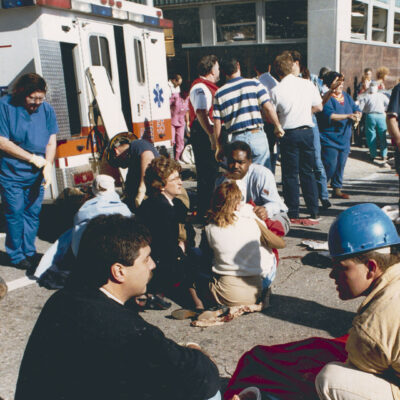Lesson Plan
Using the Legislative Process
Citizens have the power to change the path of inequality in our country without using violence as a tool of fear. Martin Luther King Jr. spoke proudly when he stated, “Injustice anywhere, is a threat to justice everywhere.” It was truly an injustice for 168 people to lose their lives in such a sinister act of terror. Every person in Oklahoma City was affected by the events that took place at the Alfred P. Murrah Federal Building on April 19, 1995.
As a sense of hopelessness and despair gripped the state, many families of those who were killed made a powerful decision. These families made the decision to stand up against the weight of this disaster and work together to change laws through the legislative process. The valuable lesson that lies within these events shows students that violence is not the answer; furthermore, peaceful solutions can be reached with hard work and bravery. The impact of legislation these families fought for was profound and brought justice and hope to many of those suffering from heartbreaking losses.
Lesson Summary
Students will analyze and examine the legislative changes that took place following the Federal Building bombing. Students will then decide their own method of changing laws in a peaceful manner.
- Essential Questions: Can one person change the laws of an entire country?
- Time frame: 2-3 class periods
- Subject(s): Social Studies and English
Materials Needed
- Pencil
- Notebook Paper
- Colored Pencils
- Markers
- Poster Paper (to use with 4 corners strategy)
- RAFT Handout
Lesson
Students will read a set of statements about justice and decide how truthful the statements may be in a strategy called always, sometimes or never true.
-
- Students will read a set of statements that focus on justice and the effects of the legislative process.
- For each one, they will choose the answer that best describes how often the statement is true: always, sometimes or never true.
- After each answer, students write a short justification regarding their response.
- As an optional end to this activity, students can participate in a whole-class discussion or share their responses.
Use the following statements:- “Injustice anywhere, is a threat to justice everywhere.” – Martin Luther King Jr.
- “Justice will not be served until those who are unaffected are as outraged as those who are.” – Benjamin Franklin
- “Social justice cannot be attained by violence. Violence kills what it intends to create.” – Pope John Paul II
Students will read information about the Antiterrorism and Effective Death Penalty Act of 1997 and Victim Rights Clarification of 1997 and identify main ideas, underline details and learn new key terms.
- Provide students with the background/overview of Effecting Change: Using the Legislative Process. As they read, have students: circle new words, underline details to support main ideas, and star the main ideas.
- Students can either read through the document once before reading through it again to mark it up, or they can mark important parts of the text as they read through it the first time.
- Once they have finished reading, partner students with one another or have them select their own partners. Students discuss what they circled, underlined, and starred with their partner.
- Students then share with the rest of the class.
Students will use their newly formed knowledge to produce a poster with a color, symbol and image (CSI).
- Color, Symbol, Image (CSI): Students will use the concept of the legislative process in a democratic nation. Students should write what they already know about this idea.
- Independently or in small groups, students then select a color, create a symbol and draw an image that represents the legislative process and have them justify their choices.
- Once their colors, symbol, and images are complete, students can share their CSI boards with the rest of the class.
Students will create their own written responses to laws they would like to change using the Role, Audience, Format, and Topic (RAFT) technique.
- After reading and analyzing the legislative process, students will use the RAFT strategy. The teacher should hand out the RAFT to students.
- Describe each of the RAFT categories using simple examples. Teacher Tip: Model how to write responses to the prompts and discuss the key elements as a class.
- Students then choose a row of the RAFT to use as a prompt. Students write their assignment based on the prompt they selected.
- It is optional to have a few students read their RAFTs aloud. Another way of discussion is to have a whole-class discussion about all of the RAFTs that were read out loud – even if they used the same role, audience, format and topic.
Effecting Change Raft
Directions: Students will choose one of the roles below. The written assignment should be one page in length. Be sure to pay attention to who your audience is, what format your writing assignment will be, and the topic you will be writing over.
okcm-c2c-lesson-plan-effecting-change-raft
Oklahoma History 5.10 Cite specific textual and visual evidence to analyze the causes and effects of the domestic terrorist attack on the Murrah Federal Building in Oklahoma City including the responses of Oklahomans to the event, the concept of the Oklahoma Standard and the creation of the Oklahoma City National Memorial & Museum.
English Standard Covered 12.8.W Students will write independently over extended periods of time (e.g., time for research, reflection, and revision) and for shorter timeframes (e.g., a single sitting or a day or two), vary their modes of expression to suit audience and task, synthesize information across multiple sources, and articulate new perspectives.
NCSS Standard D2.Civ.8.3-5. Identify core civic virtues and democratic principles that guide government, society, and communities.
D2.Civ.2.K-2. Explain how all people, not just official leaders, play important roles in a community.
D2.Civ.13.9-12. Evaluate public policies in terms of intended and unintended outcomes, and related consequences.
Always, Sometimes, Never True – Keeley, P., & Tobey, C. R. (2011). Get the facts. In Mathematics Formative Assessment: 75 Practical Strategies for Linking Assessment, Instruction, and Learning (pp. 57-59). Thousand Oaks, CA: Corwin, SAGE.
Color, Symbol, Image (CSI) – Keeley, P. (2015). Science formative assessment: 50 more strategies for linking assessment, instruction, and learning. Thousand Oaks, CA: Corwin, SAGE.
RAFT – West Virginia Department of Education. (n.d.) RAFT. Retrieved from https://wvde.state.wv.us/strategybank/RAFT.html





